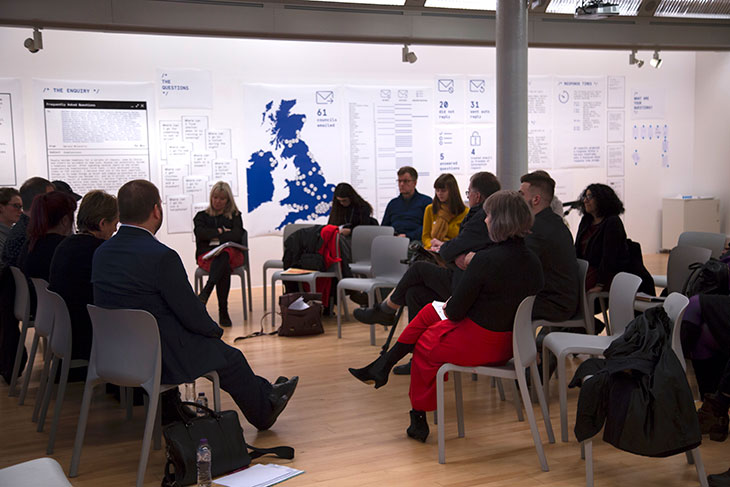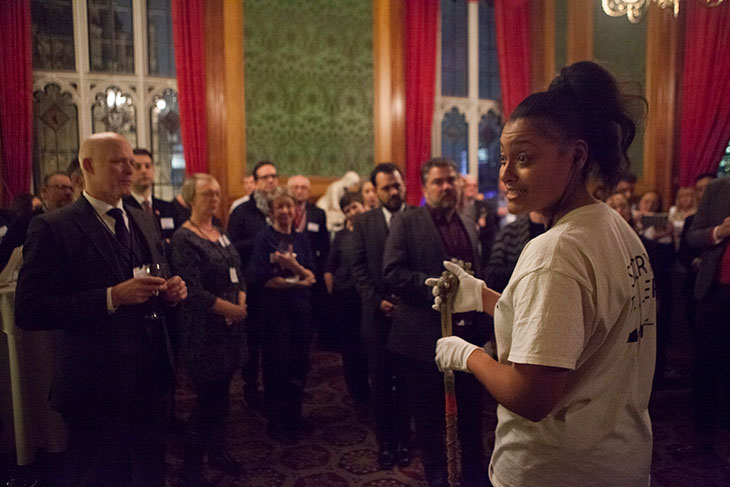From the September 2021 issue of Apollo. Preview and subscribe here.
The first time I speak to Jess Turtle, co-founder of the Museum of Homelessness (MoH), on the phone, she is just about to travel to Oxford to collect objects. This is part of the process by which members of the organisation gather artefacts and, equally importantly, the stories that go with them, to help draw a picture of homelessness today with the hope of changing things in the future.
Some of the objects the museum has collected were displayed in an interactive exhibition called ‘Objectified’ at the Manchester Art Gallery in autumn 2018, in which actors told stories about unlikely artefacts: about, for instance, a black bin bag (‘they’re getting a lot of bad press at the moment because they’re plastic and they don’t die, but, when you’ve got nowhere to put your stuff in, and your whole life is falling apart, you just end up putting all your stuff in black plastic bags, and… they become your mates’), a pack of cigarettes, a nit comb or a baby’s bottle. This autumn, a new project, ‘Reframe the Narrative’, will provide another chance to see objects collected by the museum. It plans to ‘tell the community’s perspective on what happened in 2020’, focusing on ‘the solidarity and underground organising that happened to save lives’.
Unlike many museums, the Museum of Homelessness, founded by Jess and Matt Turtle in 2014, doesn’t have a dedicated space to show its collection, at least not yet. The couple currently share an office with the Outside Project, an LGBTIQ+ community shelter, at the end of a quiet street in Borough, in south London; previously, they shared space for two years in what was the oldest operating fire station in the UK, in Clerkenwell.
The MoH is one of a number of museums set up by members of communities who felt their stories had been told for them – and sometimes even against them. The Turtles are very fond of Rio de Janeiro’s Museu da Maré, which was created by residents of Maré, an agglomeration of 16 favelas set in the North Zone of Rio. This very political museum seeks, according to its website, ‘to create a self-representation of the Maré favela’ and ‘build a positive image of the favela and its inhabitants’. The Turtles have also studied the Danish Welfare Museum, which is housed in a former poorhouse in Svendborg. Closer to home, the MoH founders also have an affinity with the Vagina Museum, which opened in London in 2019, as well as the Museum of Transology, whose founder started collecting objects among Brighton’s trans, non-binary and intersex communities in 2014.
When I visit them in Borough, the Turtles take me to an allotment garden tucked away between nearby houses. ‘A story of homelessness has always been told,’ Matt says, ‘but it’s not a particularly balanced story. Often it’s a social welfare story, a history of social work, a history of social care, of housing law. It’s very dry, and uses quite dehumanising language to describe people. It felt like there was a huge gap missing when it comes to reflecting people’s lives and experiences.’
The MoH, which became a charity in 2015, has had a somewhat peripatetic life, often collaborating with other, bigger, brick-and-mortar museums. In 2017, Tate Modern invited it to launch ‘State of the Nation’, a year-long series of events and campaign about homelessness, which it later took to Tate Liverpool. ‘Objectified’ explored the hidden causes of homelessness and examined, with the help of a neuroscientist, the dehumanisation of homeless people. Since April 2019, the MoH has taken on the ‘Dying Homeless’ from the Bureau of Investigative Journalism, a project documenting how many people die from homelessness in the UK. During the pandemic, it turned all its energies to providing emergency support to homeless people. This involved successfully lobbying the government to make provisions for the homeless and setting up, with other organisations, the ‘Covid Task Force’ to make and deliver food to people living in temporary accommodation and to the streets. ‘Some of our pandemic learning has been about what’s needed for a world in which there are ecological and economic crises happening all the time and how can we be a best fit for that as an organisation,’ Jess tells me.
The ‘Frequently Asked Questions’ project, part of ‘State of the Nation’ at Tate Liverpool in 2018. Photo: Anthony Luvera

Mitchel Ceney, who has spent time sleeping rough and now works as an illustrator, has said that art workshops provided by the hostel he lived in for 18 months helped him recover his interest in the arts. They were run by the artist David Tovey, who has also been homeless and is closely involved with the MoH. For Arts and Homelessness International, an organisation that has been building bridges in the sector, Ceney has been training museum staff on how to better welcome homeless people. According to him, ‘Libraries, as a public space, have a longer experience of being used by people who don’t have anywhere to go. Galleries have an air of exclusivity.’ He teaches museum staff that homelessness refers to a variety of situations (for instance, people sofa-surfing or living in overcrowded accommodation), which means people have a variety of needs. Ceney says people experiencing homelessness are unlikely to go anywhere that is not free, that they often struggle with the amount of stuff they have to carry, and recommends that if someone has fallen asleep in a museum, staff wake them up gently and ‘Maybe offer people a glass of water?’
Welsh charity The Wallich, which was originally a grassroots community run by homeless people and founded by Jess’s parents in Cardiff, has been running artistic programmes for a while. It is currently running a two-year project called ‘In the Margins’, which allows the people it supports to test and explore different art mediums in different parts of Wales. In 2017, it collaborated with the National Museum Cardiff, to produce an exhibition called ‘Who Decides?’
Of the environment in which she grew up, Jess says it was ‘a really interesting place, a sort of community that doesn’t exist much any more, if at all’. From the start, the Turtles say, they sought ‘a mechanism which makes sure [they] don’t have too much power’, which is why they set up a ‘core group’ of people who have been homeless themselves; this was ‘inspired by the therapeutical communities in the 1960s and the ’70s, where you’d have a structure of meetings which helps you to devolve power and make decisions as a group’. It is the core group that takes big decisions: for instance, who the museum accepts money from (crucially, never central nor local government) and who is paid what. Since becoming an employer, in 2020, the charity has opted for a flat pay structure.
When I ask Jess to tell me more about what the MoH is, and why it keeps changing shape, she says: ‘If we were to say that the museum is anything, I think it’s most strongly a community, and then the community decides what the museum is at any one time. So, sometimes the community decides that the museum is going to be marching at a protest. Sometimes they decide it’s going to be like a law clinic on the street and we make it into that. Sometimes they decide it’s an emergency food hub and we make it into that. Sometimes they decide it’s going to be – literally – a museum, but we’re going to set up that museum outside the Home Office, so then we make it into that. It’s really fun.’
The organisation also benefits from being outside the formal homelessness sector. This matters, the Turtles explain, because they work ‘for people who the system has failed, who have had a really hard time interacting with NGOs, homelessness charities and government agencies’. The MoH is therefore able to critique a sector that Matt describes as becoming increasingly ‘NGO-ish’, by which he means that it is ‘very predicated on charity fundraising messages, which often reinforce a lot of negative stereotypes which don’t look at the causes of homelessness’. As an independent body, the museum can challenge unhelpful narratives. ‘I think some people working in the sector appreciate it because maybe the Museum of Homelessness can say things that the larger charities can’t say,’ Jess says.
An event hosted by the Museum of Homelessness at the House of Lords in 2019. Photo: Steve Brown

There are, of course, traditional museums in the UK that work with homeless people. The Fitzwilliam Museum in Cambridge, for instance, has been running a programme with the charity Wintercomfort for around 10 years; their work now includes a consortium of museums across Cambridge. For educator Jacqui Strawbridge, this means welcoming a group of homeless people once a month, to look at a major exhibition. ‘You can go to all different places and points in time, from Cycladic time to the modern world,’ she says. ‘I don’t know what people’s lives are like outside, but one of the comments that struck us was… this gentleman who said that coming here and being in this studio, it’s like a womb, because it felt that safe.’
Anthony Luvera is a photographer who has been collaborating with homeless people for almost 20 years. In many of his projects, the subject of the photo, assisted by Luvera, makes and selects the picture. In 2019, he and Gerald Mclaverty worked with the Museum of Homelessness on a project called ‘Frequently Asked Questions’, for which they contacted local authorities across the UK to ask how homeless people could access basic facilities. Luvera tells me that, in his broader practice as an artist and educator, he has worked with lots of education departments of museums and galleries, such as the National Portrait Gallery, the Photographers’ Gallery, the Royal Academy of Arts and the Barbican. ‘Each of these places do fantastic work, which is about enabling access or enabling wider participation to audiences who may or may not have access to those cultural spaces.’ But for Luvera, ‘It’s not just about bringing people in on a special day, or for a special workshop […] It’s about co-creation […] if you’re co-creating the objects, the experience, the institution, the museum, there’s a whole different power dynamic that can play out there,’ he tells me.
Jess’s father used to tell her stories about his life in London in the 1950s and ’60s, before he moved to Wales. He told her that, when he and some friends were living outdoors on Villiers Street, off the Strand, the authorities started hosing them down at night with a water cannon. ‘So my dad and his mates decided to get organised. They found out where the fire engines were starting from. They would jump on the back as they were moving and empty the water tanks, so that when they got to the community they didn’t have any water to hose them. I grew up on stories like these. And it was so important to me, not only that my family was homeless but that we fought back,’ Jess says.
While supporting homeless people during lockdown, the Turtles found out that people sleeping on Southampton Street, also off the Strand, had had their tents and bedding hosed down by staff from Westminster City Council. They launched a campaign and made it stop. ‘I thought, all these decades later, we have to fight the same battles and we’re the next generation having to do that. To me there’s something really precious and evocative about London. The streets have these battles woven within them. History is alive today.
From the September 2021 issue of Apollo. Preview and subscribe here.


